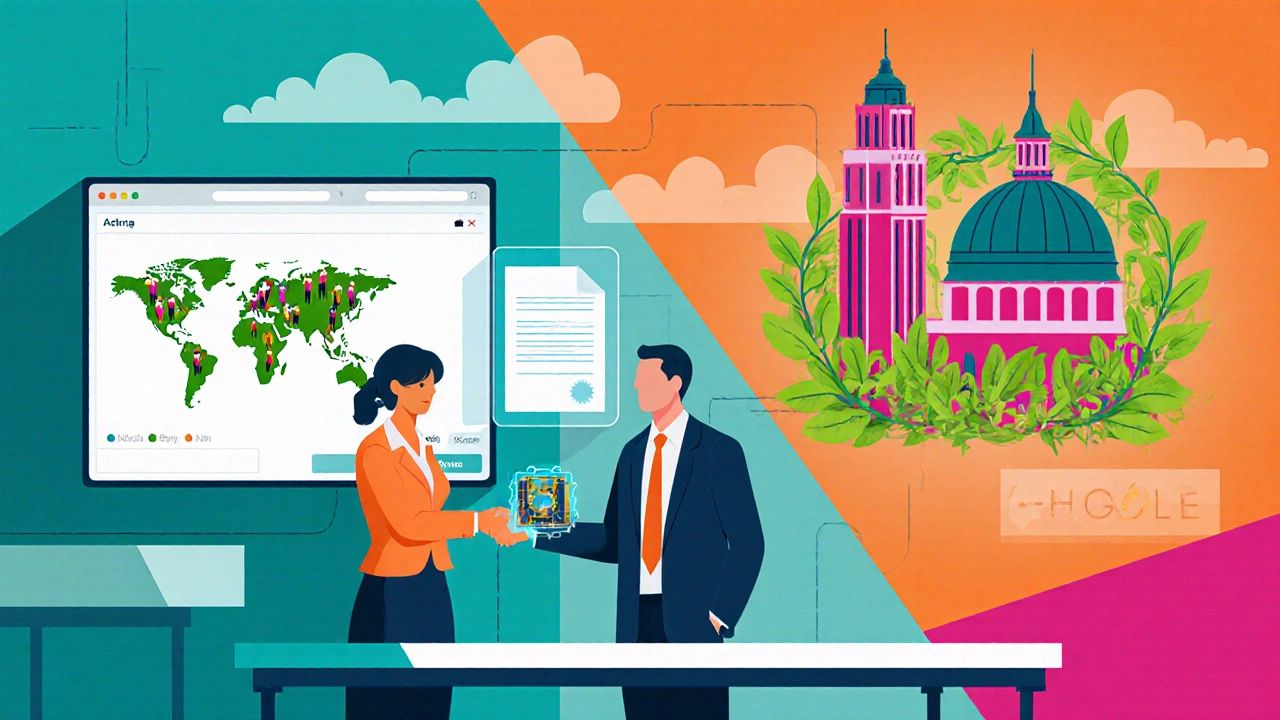Open vs. Closed Innovation Comparison Tool
Compare the key differences between open innovation and closed innovation across important business criteria. Select the criteria you want to compare to see which approach offers advantages for your specific situation.
Comparison Results
When companies talk about staying ahead, they often mention open innovation. But what does that actually mean? In simple terms, Open Innovation is a strategy where firms deliberately use both internal and external ideas, as well as internal and external paths to market, to accelerate their innovation processes. It flips the old “closed” mindset that only relied on in‑house research. Instead, businesses treat the world’s collective knowledge as a resource, tapping into universities, startups, customers, and even competitors.
Why Open Innovation Matters for Policy Makers
Governments that aim to boost national competitiveness increasingly embed open innovation into their policies. By encouraging public‑private partnerships, they create an Innovation Ecosystem where knowledge flows freely. This leads to faster technology transfer, more jobs, and higher economic growth. For example, the European Union’s Horizon Europe programme explicitly funds collaborative research that crosses institutional borders.
Core Principles of Open Innovation
- External Knowledge Sourcing: Companies look outside for ideas, technologies, or solutions they don’t have internally.
- Out‑licensing and Spin‑outs: When a firm has surplus IP, it can license it out or create a spin‑off to let others commercialize it.
- Co‑creation with Users: Involving customers early in product design turns them into partners rather than passive buyers.
- Shared Risk & Reward: Partners split development costs and later share profits, reducing the financial burden on any single entity.
Open vs. Closed Innovation: A Quick Comparison
| Aspect | Open Innovation | Closed Innovation |
|---|---|---|
| Idea Source | Internal+External | Internal only |
| IP Management | Licensing, joint ownership | Strict internal control |
| Speed to Market | Accelerated via partnerships | Often slower, due to limited resources |
| Risk Distribution | Shared among partners | All risk remains internal |
| Typical Tools | Crowdsourcing, open‑source platforms, university labs | In‑house R&D labs |

Key Enablers and Tools
Several mechanisms make open innovation practical:
- Crowdsourcing Platforms - Sites like InnoCentive let firms post challenges to a global solver community.
- Open‑Source Communities - Projects like Linux demonstrate how shared development can produce robust, widely adopted technologies.
- Technology Transfer Offices (TTOs) - Universities use TTOs to commercialize research, creating a pipeline of external innovations for firms.
- Triple Helix Model - The collaboration of government, academia, and industry forms a structural backbone for open innovation.
Real‑World Examples Across Sectors
Seeing the concept in action helps solidify the idea. Here are three vivid cases:
- Procter & Gamble’s Connect + Develop: The consumer‑goods giant set up an online portal where inventors could submit ideas. Over 30% of new product concepts now come from outside partners.
- BMW’s Open Innovation Lab: By partnering with startups through the “Startup Garage,” BMW integrates cutting‑edge mobility solutions faster than building everything in‑house.
- India’s Defence Research and Development Organisation (DRDO) and the Open‑Source Drone Initiative: DRDO released basic drone designs under an open‑source license, inviting hobbyists and firms to improve them, leading to a rapid increase in low‑cost UAV capabilities.
Potential Pitfalls and How to Avoid Them
Open innovation isn’t a silver bullet. Companies often stumble over:
- IP Misalignment: Without clear licensing terms, disputes can arise. Draft robust agreements early.
- Cultural Resistance: Employees may fear losing relevance. Offer training and incentives to embrace external ideas.
- Quality Control: Not every external contribution meets standards. Implement a rigorous evaluation funnel, sometimes called an Innovation Funnel, to filter concepts.

How Policymakers Can Foster Open Innovation
Governments can play a catalytic role by:
- Providing tax incentives for firms that co‑develop with research institutions.
- Funding open‑access repositories and data sets that lower entry barriers for startups.
- Streamlining regulations around joint IP ownership and cross‑border collaborations.
- Setting up national innovation hubs that physically bring together academia, industry, and government - a concrete embodiment of the Triple Helix Model.
Key Takeaways
- Open innovation turns the world’s knowledge into a shared resource, speeding up product development.
- It relies on external sourcing, co‑creation, and flexible IP arrangements.
- Policymakers can boost national competitiveness by creating supportive ecosystems and clear legal frameworks.
- Successful examples span consumer goods, automotive, and defense sectors, showing the model’s versatility.
- Avoid common traps by setting up clear contracts, fostering an open culture, and applying a rigorous innovation‑funnel filter.
Frequently Asked Questions
How does open innovation differ from open source?
Open source is a licensing model that makes software code freely available to use, modify, and distribute. Open innovation is a broader business strategy that may use open‑source software, but also includes crowdsourcing, external partnerships, and joint IP ownership across any type of technology or product.
Can small startups benefit from open innovation?
Absolutely. Startups often lack deep R&D budgets, so tapping into university labs, crowdsourcing challenges, or larger firms’ open platforms lets them access advanced tech without heavy upfront costs.
What legal issues should companies watch out for?
Key concerns include defining ownership of jointly created IP, ensuring confidentiality where needed, and complying with antitrust rules when collaborating with competitors. Clear contracts and a well‑structured IP policy are essential.
How do governments measure the impact of open innovation policies?
Metrics often include the number of cross‑sector patents, R&D spending linked to public‑private projects, growth in start‑up formation, and the speed at which public research moves to market.
Is open innovation suitable for all industries?
While most sectors can gain from external ideas, highly regulated fields like pharmaceuticals must navigate stricter compliance and safety standards. Still, even pharma uses open innovation through clinical trial networks and biotech collaborations.





